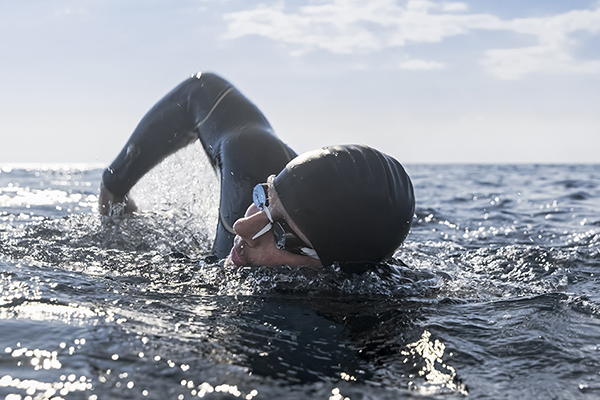



| By Dr. Ronald Hoffman

With the pandemic came pool closures. I’m an inveterate year-round swimmer, blessed with easy access to the beach at my Long Island home, but my Y pools in New York City, and those in New Jersey where I sometimes weekend, were shut.
So, I embarked on an experiment last year. Because triathlons were canceled, some wetsuit brands were apparently stuck with inventory and offered huge discounts. I availed myself of one, the Xterra Vengeance, for a third of the regular price, and scored neoprene gloves, booties, and a thermal cap.
Determined to extend my outdoor swim season here in the northeast, I kept swimming at the beach past my usual terminus in September and donned protective gear as the water temperatures plummeted. My limit turned out to be November 15, when the saltwater bay chilled to 56 degrees.
That’s a temperature that takes some getting used to. The wetsuit allows water in, but your body heats it to form a thin layer of insulation. But it works best if your suit is skintight, which means putting it on is a 20-minute ordeal of tugging and pulling.
The toughest part is putting your face in the water. Despite goggles, your mouth and cheeks are immersed uncovered, and that can give you a momentary ice cream headache.
But oh, the exhilaration once you get going! The water is crystal clear; you can see tiny bottom features, and an occasional little fish or crab startled by your intrusion. The iridescent bubbles sparkle in the autumn sunlight. Your breath synchronizes with your strokes as you carve a wake through the glassy surface of the water.
The wetsuit went fallow during the winter, but fortunately, my Y opened to limited swimming in February. As the water temperature gradually rose back into the 50s this spring, I cracked out the neoprene and got an early start on the summer season while the beaches remained deserted.
Two books on swimming informed my enthusiasm for the sport this year: Swim: Why We Love the Water by Lynn Sherr (2012) and Why We Swim by Bonnie Tsui (2021).
Lynn Sherr, a broadcast journalist and casual recreational swimmer, embarked on a romantic quest to swim the Hellespont, the four mile channel that separates Europe from Asia Minor, replicating the legendary swims of Leander and Lord Byron. She accomplished the feat in her 60s, a grandmother and cancer survivor.
Bonnie Tsui, a lifelong devotee of swimming, took up the challenge of open water swimming, negotiating the frigid waters of San Francisco Bay to swim to Alcatraz.
Both books are interspersed with historical facts about swimming. We learn that the ancient Greeks prized swimming (It is said that swim ability enabled the Greeks to prevail over the swim-illiterate Persians at the decisive sea battle of Salamis in 480 BC), but the sport experienced a decline in the West until the 1800s, when it underwent a resurgence. The first public pools were built in England, and swimming became a popular pastime, embraced by aristocrats. Benjamin Franklin, always in the vanguard, was an inveterate swimmer.
In the 20th Century, intrepid swimmers took up the challenge of swimming the English Channel. The Olympics helped popularize swimming, with such champions as Duke Kahanamoku of surfing renown, Buster Crabbe, Johnny Weissmuller who later starred as Tarzan, and Esther Williams who went on to movie fame in choreographed swim extravaganzas.
We tend to take for granted the modern swim strokes—breaststroke, butterfly, backstroke, and crawl—but they’re a recent innovation, honed in the early 20th century. Ancient swimmers, and members of aquatic cultures like traditional pearl divers and Polynesians, had their own hybrid strokes.
And, of course, there were all those outlandish rules about modest attire, even when swimming. Women had to wear cumbersome swim dresses with leggings to conceal their figures; men wore one-piece suits because the male chest was not felt suitable for viewing.
The popularization of swimming did not escape inequities. For a long time, pools were segregated, and they tended to cluster in affluent suburban white neighborhoods. As a result, and due in part to entrenched cultural attitudes, swim literacy lags among minorities. Tragic drowning statistics attest to the effects of disparities.
I believe that universal swim literacy is a cause worth championing, not just to save lives, but to afford all people a lifelong healthy recreational option.
The health benefits of swimming are extensively documented in the two aforementioned books. For me, swimming helps me diversify my training, affording an opportunity to rest muscles taxed by running and cycling, and allowing me to stay aerobic while suspended weightlessly. It’s an upper-body workout, and it strengthens my core, staving off back pain. The rhythmic breathing is like a form of meditation. I usually emerge from a long swim feeling refreshed and invigorated. Hence its appeal to so many who are “hooked” on swimming. And, unlike some more punishing activities, it can be pursued long into your senior years.
There’s also an emerging science on the benefits of cold exposure. Immersion in cold water generates endorphins; it also encourages the proliferation of brown fat, the fat-burning kind.
Of course, for the novice swimmer, attempting to swim involves overcoming the innate fear of sinking, and resisting the natural inclination to hold your breath while immersed. I get it that some people find it hard to get past that. That’s why early swim training, like learning a new language, is best accomplished when you’re very young. It’s a skill well worth acquiring.
As to some of the feats described in the books, like free-diving hundreds of feet down while holding your breath, swimming amid ice packs at the North Pole, or channel crossings, I think I’ll forego those ordeals and keep to my routine of moderate aquatic exertions.
I just like swimming.
Though we think of declining estrogen as the hallmark of menopause, it's actually common for…

Up to 12 percent of Americans have ulcers at some point in life. Peptic ulcers…
Gallbladder disease is a modern illness. An estimated 20 million Americans have gallbladder disease. The…

Dr. Antonio Bianco, recipient of the American Thyroid Association’s John B. Stanbury Thyroid Pathophysiology Medal,…

There’s a misconception among low-carb dieters. Many people believe a low-carb diet is much higher…

New, more powerful weight loss drugs: Drugs like Wegovy, Rybelsus, Ozempic and Mounjaro/Zepbound are revolutionizing…

Q&A with Leyla, Part 1: ‘Good’ Bacteria

Our virtual voicemail is open 24/7, so there's no need to wait to submit your questions for Dr. Hoffman. Leave a message, and you may hear your question featured on the Intelligent Medicine radio program!